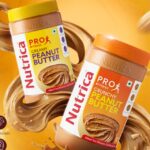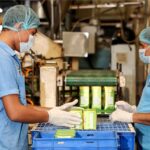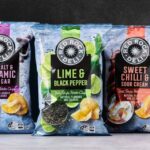The objective of freezing a commodity is to preserve and prolong its life. However, at every step – warehousing, stacking, transportation, etc. – frozen food undergoes through a series of physical and thermal rigours. During such times good packaging plays a complementary role and protects it from spoilage. Therefore the right packaging is essential for keeping the quality of food and increasing its shelf life, explains O.S Gautam.
Table of Contents
The objective of freezing a commodity is to preserve and prolong its life. Fruits, vegetables, fish and several other food items are very seasonal in nature. Freezing enables the surplus of the season to be preserved and make it available throughout the year and to a wider geographic area. Frozen foods keep well at or below –18 degree Celsius. Any upward temperature fluctuations may result in the activation of microbial, enzymatic, and oxidative activities which may either degrade the food value or render the product unfit for human consumption altogether.
However, it is almost impossible to keep frozen food without some degree of temperature fluctuation and abuse. At every step – warehousing, stacking, transportation, loading, unloading, merchandising, and retail shelf – frozen food undergoes through a series of physical and thermal rigours. During such times good packaging plays a complementary role and protects it from spoilage. Therefore the right packaging is essential for keeping the quality of food and increasing its shelf life.
Packaging of Frozen Foods
First and foremost objective of packaging is to protect a product from physical, chemical and biological hazards. It also performs various other functions i.e. making product handling and transportation much easier, easier storage and stackability, space utilization, for carrying information to customer, enhancing products’ appearance and consumer appeal , brand propagation and advertising and so on.
A good packaging with gas barrier properties is desired to pack frozen products for retail, as air inside the cold storage is dry and has a strong affinity to moisture. In poorly packaged foods, the air has a free passage in and out of the pack and keeps drawing moisture from the product. Eventually, the product loses its juiciness and gets dried and fibrous. If the frozen food product is not wholesome like ground meat, ready foods where ingredients have already been chopped and have vast cut surfaces and water is no more bound inside the tissue cells, it speeds up the process of dehydration.
Even wholesome product, if not packaged properly, get dehydrated. Bruised points and injuries and cut surfaces then become diffusion point from where dried cold air of the frozen warehouse starts withdrawing moisture. Water evaporates at every stage, even in frozen state of a commodity, due to high water vapour pressure inside the product and low outside. At any point where the commodity is unprotected from glaze and air inside the packaging and the air outside the packaging has access to the internal mass of the commodity becomes a diffusion point.
To supplement moisture loss from outer layers of the product and tissues, inner layers keep supplying moisture, resulting in a dried, fibrous, and dehydrated product over time. Only a packaging with gas barrier property or which is impervious to air and gases can arrest this process.
Free passage of air in and out of packaging also triggers fat oxidation and the frozen food product may become rancid very fast due to the break down of triglycerides into glycerol and free fatty acids. Free fatty acids react with oxygen to form various types of peroxides which generally possess unpleasant rancid smell.
Aromatic substances, which are most volatile oils and are responsible for specific flavours of food, are also subject to oxidation and evaporation along with moisture migration. Although glazing a product with a thin layer of ice, marinades or any other coating like battering, breading etc protects it from dehydration up to some extent however several prepared foods and ready meals can not be glazed.
Free passage of oxygen in and out of the packaging also attributes to the oxidation of natural colour pigments in the fruits, vegetables and meats. Therefore good packaging is very vital to protect food. Apart from moisture migration and oxidation, packaging needs to protect the commodity from microbial, physical and chemical contaminants from outside and also protect it from rigours of handling, transport and warehousing up to some extent . However, packaging can not change or better what is already inside the commodity. Packaging can only preserve the status of the product, it can not change or better it.
You may also like to read…
- NITI Aayog Declares Mizoram as “Ginger Capital of India”
- Gulfood 2026: Expanding Horizons in Global Food Trade
- Nutrica Launched Peanut Butter to Strengthen Wellness Portfolio
- Govt to Launch New Round of PLI to Boost Food Processing Growth
- Overview of Honey: Composition, History, Cultural Significance, and Therapeutic Benefits
Properties of Packaging of frozen foods
Packaging of frozen food should have the following properties:
- Should be able to withstand subzero temperatures for the length of commodity’s shelf life. Certain materials become brittle and fragile at low temperatures.
- Should be made from food-grade material and not leach out its contents and flavours into food.
- Should have the strong mechanical strength to hold the product and protect it from physical rigours of handling, transport, loading, unloading and the pressures of the shelf.
- should be impervious to gases and air.
- Should not be permeable to water vapours. Permeable materials cannot be used with high moisture food otherwise product gets dehydrated very fast.
- Aroma permeability – packaging material also should have capacity to hold aromatic substances in the food from getting evaporated or getting oxidized.
- Bacterial permeability – packaging should protect food from microbial invasion from outside and packaging material itself should not be a medium for their development.
- Salability – packaged food will certainly should be properly sealed within the pack. Therefore packaging material should have good sealing property.
- Printability – should be printable, as it has to carry labeling information.
- Aseptic – should not be itself a source of contamination to the food.
- Should protect food from exposure to sunlight as ultraviolet and infra red rays of sun have degrading impacts on food.
- During freezing, biological water gets converted into ice, which results in an increase in volume. Therefore packaging should be flexible enough to accommodate such expansion.
Packaging has witnessed several advancements. Various alternatives are available today to meet specific requirements. Co-extruded, laminated and multilayered and several combinations of compounds are available. Polyethylene, polypropelene, cellulose, cellophane, polyvinyl chloride, polyester, nylon, polyamide, aluminium foils and several combinations are used to develop good packaging materials.
Cardboard boxes still make a good outer packaging with better mechanical strength and easy printability. They do not make a good retail pack for frozen foods unless they are wax coated or coated with soma polymer. Card board boxes can not withstand rigorus of temperature abuse in the retail shelf. On-the-shelf product is freely available to customers for a glance of product and reading the labels.
As it is frozen and temperature is low, once the frozen food product is out of the display freezer, it comes in contact with ambient air, laden with high moisture contents. This moisture condenses over the box, which absorbs it and gets soggy in due course and as a result it looses its mechanical strength to hold the product. However, lamination, waxing, and shrink-wrapping reduce its moisture absorbing capacity.
Advancements in Packaging of Frozen Foods
Frozen foods can be packed in many ways – pouches, trays and cardboard boxes – whichever suits product and shelf requirements. There are several new advancements in packaging and some of them worth mentioning are as follows:
Vacuum Packing
Foods packed in vacuumised packaging keep better as the product is fully cut off from the air thus dehydration and oxidation both are arrested completely. Microbial growth is also arrested as oxygen is not available for their respiration. However there are anaerobic bacteria that grow well in absence of oxygen i.e. Clostridium botulinum (toxin produced by C. botulinum causes food poisoning), therefore it should be ensured that product is free from such contaminations at the time of packing.
Vacuum packed products enjoy enhanced shelf life and keep the quality and integrity of the commodity in a much better way than normal packing. However, the material used for vacuum packing is expensive and will have an impact on its selling price.
Packing in Modified Atmosphere
There is a new method of packing food in a modified environment. Packing in a modified atmosphere is achieved by first vacuumising the container. It removes air completely and fill the container with inert gases. Nitrogen and carbon dioxide and their mixtures are generally used for this purpose. Inert gases do not react with any component of food and thus keep it intact. They also cut off respiration for microbes.
In vacuum packing product is always at negative pressure and at any point if packaging or its sealing gets damaged, a vacuum is lost and again it is susceptible to oxidative changes and moisture migration however pressure of gases in the modified atmosphere packing is at equilibrium with atmospheric pressure. Damaged packaging will have a negative impact here also but negative pressure is not there.
Heat Stable Packaging
Laminated cellophane with polyethelene or coating aluminum with heat stable and sealable films make very good packaging. This kind of packaging comes handy in frozen “Ready to Eat” and “Ready to Cook” foods. Food can be directly transferred from ‘Freezer to Fire’ for ‘Heating and Eating’ or for thawing for further processing and cooking. Microwavable and ‘boil in’ packaging are available and is much in demand.
Edible Packaging
Now Cellulose-based casings have replaced intestines which is edible and thus becomes part of the food. As we know cellulose is a major constituent of the vegetables and fruits. However, its use is limited only to sausage production but promises a good scope for the future in packing other food products too.
Labelling of Frozen Foods
Each food package needs to carry information regarding itself, its shelf life, its producer and any other information that is helpful to a customer in any way. These are mandatory information that must be over the packaging to meet regulatory requirements and voluntary information to help customer, educate customer or even to promote and propagate brand and producer. Precautionary information like “KEEP IT REFRIGERATED” or Health-related information also could be part of labelling.
Mandatory Requirements
Food manufacturing in India is controlled by PFA Act 1955. Frozen foods do not have any specific labeling requirements and are grouped as normal food and described in rule 32 to 36 in PFA act. Regulations are enforced mainly by three major departments-
- FPO (Food Product Order) – controls the manufacturing of vegetarian foods or foods from botanical origin or their byproducts.
- MFPO (Meat Food Product Order) – controls animal origin or non- vegetarian foods.
- Weights and Measures or legal department of metrology.
The first two agencies are responsible for the approval of a manufacturing/production facility depending on the type of food. The approved plant is issued with an approval number either FPO or MFPO and a logo. The logo is issued by FPO and is symbol of vegetarian origin and thus identifies vegetarian food. The positioning of logo and its size all are described in regulations.
FPO or MFPO number of the facility, manufacturer’s full address along with telephone numbers and E-Mail address if available and country of origin (PRODUCT or PRODUCE OF INDIA) is mandatory over the packaging. An Imported product needs to have manufacturers name and address, country of origin and local distributors full address, phone and license nos.
NAME OF THE PRODUCT and its net content inside the pack or the net weight is mandatory information. Net weight should be printed in bold and in a cover page in a prominently visible area.
DATE OF PRODUCTION and DATE OF EXPIRY or BEST BEFORE or USE BEFORE is another mandatory labeling requirement.
INGREDIENTS: If food is fabricated with multiple ingredients then their labeling in descending order along with their percentage in the composition is required. If any preservative, flvour and colour are added in the food, it must be declared.
Some people are ALLERGIC to some of the food ingredients and chemicals (ALLERGENS), if declared over packaging consumers can guide their purchases accordingly.
NUTRITIONAL VALUE: Declaration of nutritional value or nutritional facts, in terms of percentage of constituents like fat, protein, carbohydrates, salt, saturated fats, trans fats, cholesterol, vitamins and minerals and energy derived from them in terms of calories is required.
The consumer who are diabetic or suffering from cardiovascular diseases get informed through the label declarations and hence can safeguard their health.
TRACEABILITY CODE: Traceability code is now insisted upon in order to trace back the history of a product’s manufacturing or source of raw material and packaging in case of any eventuality and recall. It is generally mentioned as batch no or lot no. If food is found faulty, whole lot will need to be recalled from the market. Batch code may be a day no or the date with shift or session which can be related with production history and other documents and data of the batch, hygiene and quality control data, raw material, ingredients and packaging sources for further analysis and corrective actions at the time of need.
MRP OR SELLING PRICE: To print selling price is mandatory and it must be for all reasons, so that customer is not defrauded and should be in the know of the value for money for his pick.
Voluntary Information
Frozen Food Specific Labelling
Freezer sections in the household refrigerators are meant to store frozen products for short durations in order to maintain its temperature. They can maintain the temperature of a frozen commodity but they do not have inbuilt capacity to freeze a product to -18 degree Celsius. Therefore if a product is kept for freezing in a refrigerator, it is subjected to slow freezing process which sets in nutrient migration(translocation of electrolytes) and damage to the tissue cells due to the formation of bigger ice crystals and expansion inside the cells making them burst and release all nutrients.. That is the reason most of the time frozen product are labeled with a caution slogan saying
“HOLD OR STORE AT -18 DEGREE CELSIUS”
or
“KEEP IT REFRIGERATED”
or
“DO NOT REFREEZE AFTER THAWING”
In Western countries packers also label duration of desired storage time and temperature to be maintained in the refrigerators.
They are denoted as one, two and three stars:
* one month storage –6 degree Celsius
** six months storage –12 degree cel
*** one year storage –18 degree cel
“Thaw in Running Water” Or “Freezer to Fire”
Ready to Eat (RTE) and Ready to Cook (RTC) is gaining momentum in India. This segment is witnessing a fast growth. Frozen RTE foods are “Freezer to Fire” products and do not need any thawing. They should go directly from freezer to Oven for heating before serving.
In the same way RTC food are prepared in a way to go directly into cooking vessel or the deep fryer.
RTE and RTC foods have just made entry into the Indian market and domestic Indian customers are not much experienced in handling such products. Therefore they need to be educated and that can be done by labeling such information and instructions over packaging.
Once subjected to temperature abuse, or thawing process, some of the frozen RTC foods like coated Breaded and Battered products disintegrate completely. Bread crumbs are bound with the core material with the help of batter solutions which contain gluten and hydrocolloids (glues). Gluten and glues together act as binding agents between core material and breadcrumb.
This adhesion becomes stronger after freezing due to the conversion of water from batter solution into ice that makes another bond with ice crystals of core material. When subjected to temperature abuse or thawed, ice crystals liquefy hence adhesion weakens and coating material may fall apart during frying. As customers do not know technicalities of the food, it is better to label and educate them.
Cooking Instructions
Some of the manufacturers also advise customers about cooking methods however such information is voluntary in nature. Different methods of cooking require different cooking media and cooking temperature. Like in a deep-frying process if oil temperature is lower than 170 degree celsius, first of all product is going to absorb more of oil and secondly, browning reaction and caramelisation which produces pleasant flavours and appetizing colours, may not happen. Therefore it is always advisable to provide as much of information as possible.
Bar Coding
With outlets going high tech, it has become almost necessary to label packs with bar codes. This makes the life of customers much easier and the job of the salesmen at the counter much efficient.
Brand and Image Building Information
Although not mandatory however any manufacturer will not leave any chance to highlight his brand name. In most of the packaging, this is the brand name, which is bold and bright. Companies also have the liberty to dispense with information about the product, its health benefits or functionality of food if any like LOW IN FAT or LOW IN SALT or HIGH IN OMEGA 3, FORTIFIED WITH VITAMINS AND MINERALS or ORGANIC or NATURAL or CHOLESTEROL FREE, ETC., about their company or food safety status or quality management certifications as “ISO CERTIFIED” or “HACCP IMPLEMENTED” and so on.

















